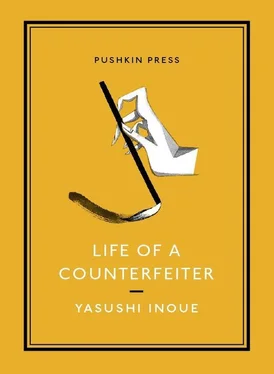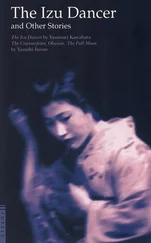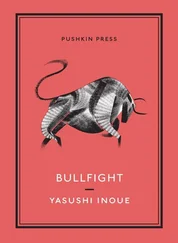Piecing together what we learned from the victims onto whom Hōsen had unloaded his forgeries, we determined that he had lived for some time in each of the small coastal cities we had visited — three years in Aioi, two in Shikama, four in Wake, and so on — but that he had never settled in any one place for as much as five years. Given that he was the sort of man to go about selling counterfeits, I suspect that after two or three years some incident would make it impossible for him to remain in each town, leaving him no choice but to move. Presumably he went on hopping from one small city to the next one in the vicinity, rather than picking up and leaving for someplace farther away, because he would have been unable to earn a living outside this region so rich in collectors of Keigaku’s work.
S., the president of a sake distillery in Wake, was the only person to whom Hōsen had introduced his wife. For whatever reason, Hōsen had brought the petite but beautiful woman to this man’s house not once but on many occasions; according to what we were told, Hōsen had gained the confidence of the previous head of the household to quite an extraordinary degree.
“I have the impression Hōsen was less a painter himself than a sort of dealer. I was still a child at the time, so my memory isn’t very clear, but I believe my father often relied on Hōsen when he wanted to commission a work from a painter in Tokyo, for example. Most of the paintings in this house came to us through him, I’d say.”
The present head of the household, who told us this, was in his forties — he had been a celebrated rugby player in college, and didn’t look as though he had much interest in paintings.
He continued: “I had the sense he was good at everything. He even carved his own seals, you know. I think we have one he did around here somewhere.”
The man looked for the seal, but couldn’t recall where they kept it.
We asked him to show us a few of the paintings by famous Tokyo artists his father had acquired through Hōsen, but they were all absolutely authentic; one was such a remarkably accomplished piece, though it was small, that it was surprising the artist had been willing to send it off to a place like this, way out in the country. Whatever Hōsen’s failings may have been, Tokyo’s painters seemed to have placed a good deal of trust in him.
“So Hōsen specialized in Keigaku,” Takuhiko said. “And he navigated very cautiously, never selling two counterfeits to the same family.”
It was true. Hōsen had been very clever, and very careful.
According to our researches, Kakogawa was the only place Hōsen had lived in twice — though we couldn’t say why. He would have been in his late fifties the second time, which lasted from 1927 to 1928; after that he had left the region behind. Or rather, he didn’t necessarily leave; he simply stopped turning up, around that time, at the houses of the local art lovers.
On the fifth and final day of our travels, on the way back from Saidaiji, we took a room in a small, well-known inn in Himeji, near the shore. We intended to relax a little, eat some fresh fish, and divest ourselves of the weariness of five days of travel. By some amazing coincidence, however, we discovered a landscape by Hōsen hanging in the alcove of our room. The first seal, in a style close to block script, was easily legible as “Hōsen”; the second and third read “Kankotei” and, once again, “Hōsen.”
Owing in part, perhaps, to our weariness after so much traveling, this odd encounter with Hōsen’s work seemed inordinately funny.
“Some strange karma seems to bind us to the great painter,” Takuhiko said. “And look here, he’s taken off the mask on this one. Surely it’s not a counterfeit of his own work!”
We remained there, still standing, cracking jokes and gazing at the scroll in the alcove. We had seen several of Hōsen’s counterfeit Keigakus, of course, but this was the first time we had encountered a work of his own, signed with his own name.
“Not half bad, is it?” Takuhiko said, looking a bit taken aback. “He could have made non-vetted status at the Ministry of Education Exhibit, I’d say.”
At the very least, it wasn’t the sort of anonymous garbage one often finds hanging in the alcove of your average inn. The subject matter was trite — part of a mountain shrouded in mist, painted in the Nanga style — but it was executed with such exquisite attention to detail that one could see why Hōsen had signed it with his own name. In some strange fashion, I felt the scene burrowing its way into my heart as I stood gazing at it.
“Odd spirit in there,” Takuhiko said.
And it was true: something in the painting called for such a description. No one who had just seen a sampling of Keigaku’s masterpieces could regard it as a genuinely superior work, but its peculiarly solitary, impoverished spirit gave it a certain attractive harshness.
“Kankotei. ‘Pavilion of Cold Antiquity.’ A perfect name for an artist,” Takuhiko said, evidently profoundly moved; then, having inspected the painting once more, he went out to the veranda and sat down on one of the rattan chairs. As he went, the sound of the name he had just uttered, Kankotei , was finding its chill way into the recesses of my own heart, and I had to agree that in some odd way it exactly matched the mood of the painting.
We spent the evening — the last of our trip — sharing a few small bottles of sake. We tended to grow most enthusiastic when the conversation turned to Hara Hōsen, rather than during our discussions of the early masterpieces of Keigaku’s we had spent the past week investigating.
The conclusion we reached was that Hōsen must have had some degree of talent, given that he was capable of paintings as good, despite their problems, as those we had seen.
“What a fool. He should have painted his own works, rather than wasting his time making stupid knock-offs of my father’s!”
Casting a sideways glance at the scroll in the alcove, Takuhiko pushed up the sleeves of the thin cotton yukata the inn had provided and raised his cup to his lips.
“I’m sure the counterfeits sold better.”
“That’s true. People would go for a Tekishintei over a Kankotei.”
“What kind of a man was he, I wonder? You have no memory of him?”
I felt a certain curiosity about this charlatan, the impression he had made.
“None at all. I was just a boy, after all, and besides, the most I would have done is catch a glimpse of him in the entryway or something. I suppose there was one time, come to think of it, when my dad was about forty, I’d say, because I must have been seven or eight…”
Takuhiko recounted his most deeply memorable encounter with Hōsen.
He had no idea where it had happened, but presumably it was an exhibition. Hōsen was kneeling on the floor with his head bowed to the floor while Keigaku towered over him.
“Lift your head and look me in the eye!”
Takuhiko had, he said, a faint memory of his father shouting these words. Keigaku was livid, he kept shouting, repeating himself, but no matter what he said Hōsen never raised his head. Takuhiko had no impression of Hōsen’s appearance, what sort of air he possessed, but he remembered feeling deeply sorry for the man, even though he was too young to understand.
“My dad must have found out about the forgeries, and… well, you know what he was like — he didn’t care, he’d fly off the handle even in front of other people. We weren’t at home, so it must have been one of my dad’s exhibitions, at some department store or museum, maybe a temple, and my dad must have caught him there. Something along those lines, I’m sure. My dad might have been helping him out financially then, too. Sounds like an old ballad the way I tell it.”
Читать дальше












